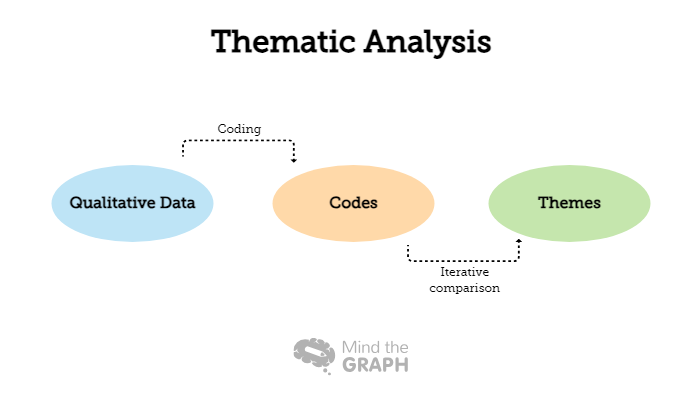
The researchers analyze the themes present in the data set to identify any particular pattern types present in qualitative data. The different researcher makes use of different types of approaches to learn about the meaning and patterns hidden in the qualitative data. Mastering the skill of using qualitative data usage can be very helpful in creating different types of themes in different types of research papers.
What is thematic analysis?
Thematic analysis refers to the process of measuring and evaluating various types of reports and data that are under the process of review. For instance, thematic analysis can be used to review the types of language used in a particular book or journal. Thematic analysis is essential as it helps in identifying different types of themes and meanings hidden in the data collected. The identification of themes plays a vital role in answering the primary research question and also aims at the objectives of the research paper. Researchers also use thematic analysis to research different topics such as focus groups, survey responses, field research, social media channels, and many more.

Thematic analysis is also considered helpful in analyzing culture, tradition, human experience, and education when researching psychological and sociological areas. The data required for thematic analysis is generally collected from people involved in the research study. The creation of thematic analysis is essential as it helps answer the research objectives and incorporate positive development of the individual in their respective field.
Different types of thematic analysis
There are three distinct types of thematic analysis conducted by the researchers. They are
- Codebook Approach: During this thematic analysis, the researchers use a cookbook to chart the entire analysis process.
- Coding and reliability approach: In this method, the researcher focuses on a coding framework to evaluate the accuracy and reliability of data used in the research work.
- Reflexive approach: In this approach, the research uses already identified themes present in the codes to interpret the information provided by the data collected.
Steps of conducting thematic analysis
Conducting thematic analysis is considered a very tricky task. As a result, the following steps mentioned in this article can be constructive in conducting a high-information thematic analysis in a research study.
- Evaluating the resources: To create a thematic analysis, it is essential to get familiar with the resources available, such as audio entries, reviewing the data collected and creating copies of original documents. Getting familiarized with the resources is very useful as it helps understand all the information in detail.
- Coding the data: Coding the data is also essential as it helps develop the themes per the requirements. Coding of data is also essential as it helps in the identification of different patterns in themes and differentiating them on their meaning. For instance, when researching marketing campaigns, it must categorize the concerns and suggestions regarding the percentage of the audience who did not like the campaign. The researcher can highlight similar words or phrases in the same color and repeat the same codes for all other processes.
- Identification of themes in data: During this stage, the coded data is further divided into larger contexts known as themes. The analysis of codes can be constructive in identifying the data, which can fit into larger groups. For instance, different groups include the interest and purchasing power of the consumers into a much broader category known as customer behavior. Customer behavior becomes the theme for these codes.
- Review of themes in data: After classifying codes into themes, it is essential to examine the themes and review them. The process of reviewing includes investigating the data sets, comparing the different themes and ensuring that all the required data are included in the themes. Moreover, it is also important to represent all the data accurately in different sets as per their relevance.
- Defining the themes: After reviewing them, it is essential to define them and provide a detailed explanation of the information present in each theme. Defining the themes helps in the completion of the research paper quickly.
- Providing data analysis: It is the last step in the thematic analysis process. In this step, information is written on the research paper. The section includes an introductory paragraph, which contains the research questions and information on the type of data analysis conducted. It also provides information regarding the data source, data analysis process and the thematic analysis conducted in the research study. Wiring a detailed analysis is essential as it helps provide a reference for future studies on the same research topic.
Advantages of thematic analysis
Thematic analysis provides various advantages to the researchers. Some of the significant advantages are
- Flexibility: Thematic analysis helps in adding flexibility to the researcher to take any approach to analyze the data collected. Thematic analysis helps change the research objectives, promotes the collection of variable data, and helps in better data analysis.
- Appropriate for large size of data: The amount of data required in qualitative analysis is considerable, which makes it challenging to analyze the data. On the other hand, thematic analysis helps in breaking the data into small sets. It helps in focusing on a specific group of data rather than focusing on all the available resources together.
- Answering the research question: The thematic approach is suitable for finding solutions to any research question. As the process of thematic analysis is subjective, it can be used to find answers to any difficult question.
Disadvantages of thematic analysis
- Hard to focus: During the process of thematic analysis, the researchers derive different sets, which results in making it difficult for the researcher to focus on all the data sets at the same time.
- Limited imperative: Thematic analysis uses personal information during the research process, which can result in neglecting the research framework. The use of personal experience can hamper the authenticity of research work.
Conclusion
Thematic analysis is a process of conducting quantitative research. It helps analyze the patterns and meaning of the data collected during the research. Moreover, thematic analysis makes use of both primary and secondary data, which makes it suitable for any kind of research topic.


